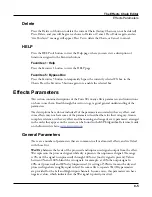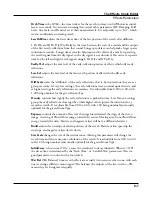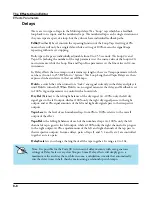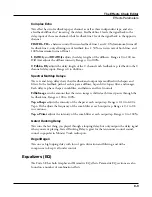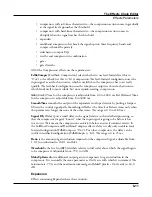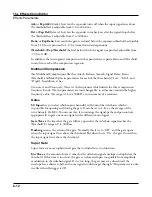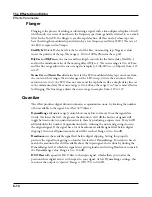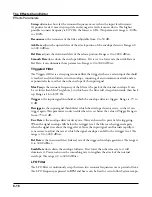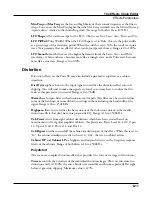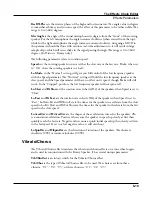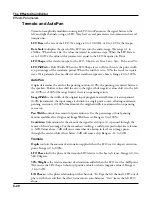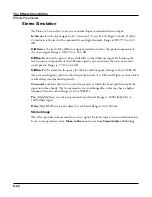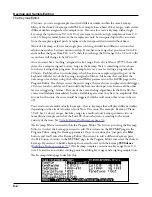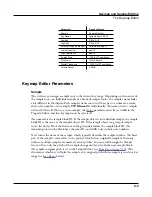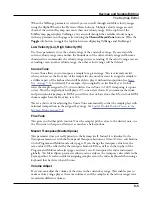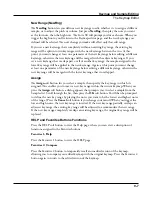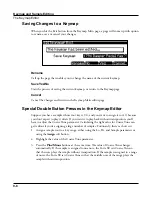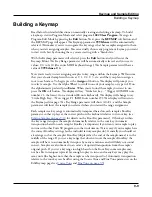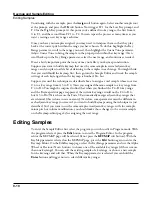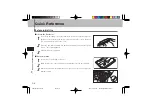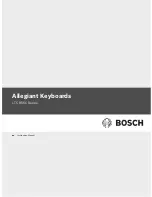
The Effects Chain Editor
Effects Parameters
8-18
LP n Freq
are shelving frequencies for one-pole lowpass filters on each of the distortion
stages. LP0 Freq handles the initial low pass prior to the first distortion stage. The other low
pass controls follow their respective distortion stages. Range is 16 to 25088 Hz.
Rotating Speakers
An effect that includes Rotating Speakers breaks the signal into two frequency bands,
“rotates” each band separately through a virtual speaker, and then combines the outputs with
a pair of virtual “microphones” whose angle relative to the speakers is adjustable. A number
of very sophisticated parameters have been included in the Rotating Speakers effect, to give
the effect a great degree of realism. Because of the complexity of the effects, you might want
to approach any parameters that seem a little obscure to you with caution.
Roto InOut
engages or bypasses the rotary speaker effect.
There are four virtual microphones, with two each on the woofer (LoMic A and LoMic B)
and on the tweeter (HiMic A and HiMic B). Each microphone has:
Pos
(position), the angle of the microphone from the front of the virtual speaker, from -180
to 180degrees;
Lvl
(level) from 0 to 100%; and Pan, the left/right panning of the microphone’s output,
from -100% (full left) to 100% (full right). Other parameters:
Lo Beam W
and Hi Beam W set the acoustic radiation patterns (“beam width”) of the two
drivers in the rotating speaker. If you imagine looking down on the rotating speaker, this is
the angle between the -6 dB levels of the beam. The range is from 45° to 360°. At 360°, the
driver is omnidirectional.
Xover
(Crossover) is the frequency at which high and low frequency bands are split and sent
to separate rotating drivers. The range is 16 to 25088 Hz.
Lo Gain
and Hi Gain are the gains of the signal passing through the rotating woofer or
tweeter, respectively. The range is Off/-79.0 to 24.0 dB.
Lo Size
and Hi Size are the effective sizes (radius of rotation) of the rotating speakers in
millimeters. This affects the amount of Doppler shift or vibrato of the low frequency signal.
The range is 0 to 250 mm.
Lo Trem
and Hi Trem control the depth of tremolo (amplitude modulation) of the signals. It
is expressed as a percentage of full scale tremolo. The range is 0 to 100%.
LoResonate
and HiResonate are simulations of cabinet resonant modes expressed as a
percentage. For realism, you should use very low settings. The range is 0 to 100%.
Lo Res Dly
and Hi Res Dly are the number of samples of delay in each resonator circuit in
addition to the rotation excursion delay. The range is 10 to 2550 samples.
LoResXcurs
and HiResXcurs are the number of samples of delay to sweep through the
resonator at the rotation rate of each rotating speaker. The range is 0 to 510 samples.


